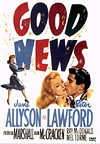Good News
Warner Home Video
Cast: June allyson, Peter Lawford, Patricia Marshall, Joan McCracken
Extras: Excerpts, Deleted Musical Scene, Trailer, Production Notes
Rating:
The bloom was apparently off the rose when the film reached the silver screen as an early talkie a mere three years later. Its look was earnest but effortful. Unfortunately, the 1929 stock market crash intervened, thrusting America into a tailspin of economic depression. For audiences with more pressing things on their minds, the folly of ’flapper’ innocents doubtless had a hollow charm. By the time the show was given a second chance in the movies, in 1947, another event of consequence had just transpired, the Second World War.
The rest of the cast is in itself a range of unexpected surprises. A sylph named Joan McCracken leads the rousing title song that opens the film. Yet another newcomer to movies, McCracken was so fascinating to watch in action that the powers that be must have felt her worthy of something more to do. The result was a new number called "Pass that Peace Pipe" which ranks amongst the greatest production numbers ever devised for the camera. McCracken was scarcely ever heard from again in movies, though she at least wowed Broadway both before and after her screen triumph here.
Something about this mix was clearly magic because the product was a seamless meld of the 20s of yore with the 1947 of the here and now. So filled was the show with engagingly kinetic musical numbers, it could easily have coasted from hoary plot point to song cue. Instead, it had the decency to make getting there part of the fun. The frivolity is laced with wit.
The show is bright and colorful, and is served here by a print that is excellent but for the occasional Technicolor misalignment. MGM prints of this period have a tendency to betray color edging. This can become distracting, but the problem is minimal here compared with another recent release, "Anchors Aweigh," which tries the patience at times.
The opening titles for "Good News" had such coarse edge enhancement and minor artifacting that I really feared the worst. The color, black level and sharpness are all consistently full enough to compensate for some otherwise disappointing qualifications. The picture is often noisy, and this noise is more consistent with digital processing than film grain. This can’t really be said to be overly distracting, but it does have a tendency to infer a slightly muddy look when the color is actually just fine. Apart from the titles, in fact, the picture is wonderfully detailed, sharp without any apparent edge enhancement or color bleed.
Rumor has it that the long lost final reel to the 1930 version of "Good News" was recently discovered. Whether it was or not, DVD is the collectors’ medium to treasure what IS there, especially if an attempt is made to bridge whatever is missing so we can at least get a sense of its complete state. The superb LaserDisc set "The Dawn of Sound II" contained the titles and seven musical numbers from the 1930 version.
Another extra is a fairly elaborate deleted number entitled "An Easier Way" created expressly for the film. I suppose, even its added weight might have been feared sufficient to sink the show, what with the excess of excellence, which already crowded it. We have to give thanks for a little gem we can enjoy now that original audiences were denied. A trailer rounds out the pleasing set of extras all which are in more than just serviceable condition.







